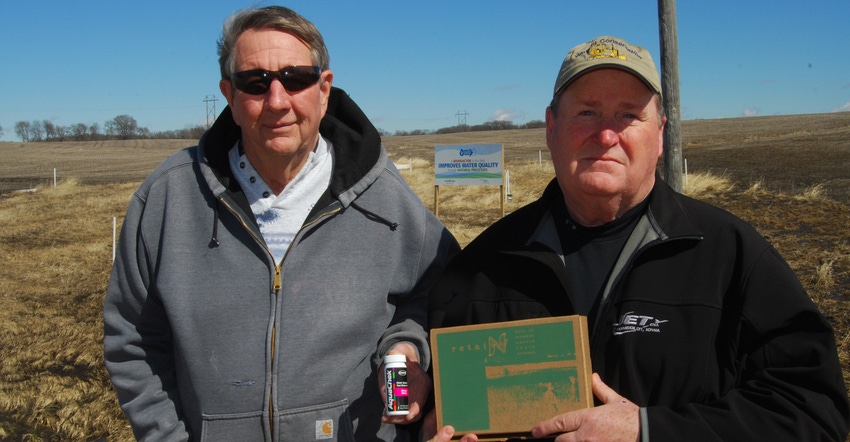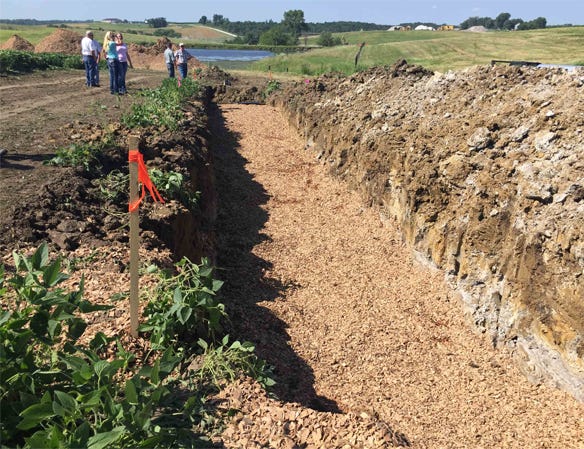April 25, 2019

Edge-of-field conservation practices are among the most effective tools for keeping nutrients out of Iowa’s waterways, but they’re among the most challenging in terms of getting such practices on the land.
Bioreactors, saturated buffers, wetlands and drainage water management are often time-consuming to plan and expensive to install, and generally don’t provide a direct financial return on investment for farmers.
The state’s voluntary Nutrient Reduction Strategy is inspiring more strategies for filtering drainage water from fields before it reaches streams. One such strategy is the installation of bioreactors at the edge of fields.
A bioreactor is a trench filled with wood chips. When water from a tile drainage line flows into it, microorganisms that feed on the wood chips convert the nitrate in the drainage water to harmless nitrogen gas. This denitrification process results in cleaner water discharged into waterways.
More cost share available
The process is relatively new, and construction is costly, but more cost-share money is now available to encourage installation of bioreactors.
Last spring, Bob Floss had a bioreactor installed on his farm near Baxter in central Iowa. “Actually, we ended up with two bioreactors — one on each side of the grass waterway where the tile drainage outlet empties into a creek,” he says. “2019 is our second year using the bioreactors, and so far, so good.”
The two tile outlet lines drain about 170 acres, and one bioreactor wouldn’t be enough to handle the flow, so they went with two.
This was the first bioreactor installed in Jasper County and a new experience for everyone involved. USDA’s Natural Resources Conservation Service supplied cost-share funding, and was involved in planning and oversight. The bioreactor was constructed by Herbold Conservation Con-tractors.
“We all learned a lot going through this, as it was our first time building a bioreactor,” says Chris Herbold, who installs tile drainage systems, builds terraces and grass waterways, and does other conservation excavation work.
More bioreactors needed
Herbold, a neighbor of Bob Floss, farms his own ground and custom-farms the Floss farm. “Bob uses many of the same practices we use on our farm,” Herbold says.
“No-till, cover crops, grass waterways, terraces, grass buffers,” he says. “I haven’t installed a bioreactor yet on my farm. But I believe they are a coming thing in field drainage and water quality management, along with saturated buffers and wetlands. Water quality and soil quality go hand in hand.”
The Iowa Nutrient Reduction Strategy’s latest annual report says Iowa needs an estimated 120,000 to 138,000 bioreactors and saturated buffers installed statewide in farm fields.
This is in combination with many other in-field and edge-of-field practices to meet the NRS water quality goals. About 40 bioreactors are in use in Iowa; thus, many more are needed.
“When we were installing our bioreactors, people would stop and ask questions. And I still get inquiries from other farmers and neighbors interested in how it works, and whether I would do it again,” Bob says. “There is a lot of interest in edge-of-field practices, as well as cover crops and in-field practices.”
USDA increases incentive
People are concerned about water quality issues; farmers and landowners are looking for answers; and more are taking action. However, with the farm economy struggling, farmers and landowners hesitate to spend money.
That’s why NRCS last year increased the cost share for certain practices funded by its Environmental Quality Incentives Program. EQIP now pays 75% for bioreactors and saturated buffers, providing an increased incentive for farmers and landowners to use these edge-of-field practices. For other conservation practices, NRCS cost share generally tops out at 40%.
In addition to federal money, state cost share and other program funding is available. The soil and water quality division of the Iowa Department of Agriculture has helped fund some bioreactors. The state will reimburse up to 50% of the cost, but annually there is a limited amount of money to go around.
The Iowa Pork Producers Association also has provided some cost-share funding for edge-of-field practices.

SIZE: Most bioreactor installations in Iowa have been about 100 to 120 feet long and 15 to 25 feet wide.

Total cost to install a bioreactor can range from $12,000 to $20,000, depending on its size, as determined by the number of acres and the slope of the land it drains.
For the two bioreactors Bob installed, each cost about $17,500, or $35,000 total. That’s for everything, including construction and wood chips. With 75% cost share from EQIP, the total cost to Bob for the two bioreactors was $7,000, or $3,500 each.
“I spent $7,000 on the whole job, which is pretty good thanks to the EQIP cost-share funding,” he says. “You have to go through the application process with NRCS, and it takes some time. Then they have to draw up the plans.”
Edge-of-field next step
Regarding conservation practices, “Dad has everything from grass waterways and terraces to cover crops and now two bioreactors,” says Craig, Bob’s son.
Craig is CEO of the Iowa Corn Growers Association. “Dad’s been planting cover crops on some fields for five years. Next year he’ll have cover crops on all his fields. He also has some [Conservation Reserve Program] acres and a contour buffer strip. He’s pretty much all no-till now and used minimum tillage for years.”
What prompted Bob to install the bioreactors? A trip with his son to a field day to see demonstrations of practices to improve and protect water quality. Iowa Corn has hosted many field days at the Land Improvement Contractors Association demonstration farm at Melbourne in nearby Marshall County.
“Dad attended a field day with me two years ago, and we looked at a bioreactor,” Craig recalls. “I told Dad, ‘You have a good spot to put in a bioreactor on your farm. It might be something you are interested in with your other practices.’”
It didn’t take long before Bob decided to install a bioreactor. At the LICA field day, contractors explained the various conservation practices. “A few days later, Dad told me he’d contacted NRCS, asking questions, seeking more information,” Craig says.
Efficient at filtering
During the past year, Chris Herbold and Bob Floss have sampled water going into the bioreactor and coming out, using test strips that come in a kit. These small strips, dipped into water, provide a reading on the nitrate content.
“A year ago, right after installing the bioreactor, we ran the first test and then had rain,” Herbold says. “A week later, we ran a second test. The water coming out of the bioreactor was already showing 17% less nitrate in one week. The longer the microbes can form in the wood chips, the better the results. We now see a 40% to 50% average reduction in nitrate content in water coming out of the bioreactor. That’s also what’s been seen with bioreactors in other counties. Bioreactors are effective at removing nitrate from water.”
On average, 50% is a common number. For all the water that actually enters a bioreactor, they are efficient. A lot of time there is a 90% reduction of nitrate in the water, but because there are bypass flows during rainy periods and high flow events, that’s where you get the 50% overall total reduction on average.
Building and managing a bioreactor
Each of the two bioreactors installed on the Bob Floss farm is 110 feet long, 20 feet wide, and 4 to 4.5 feet deep. The 6-inch-diameter drain tiles are in the bottom, running along each side. USDA’s Natural Resources Conservation Service provided the plans and the engineering.
Driving by the bioreactors, which are covered and seeded over the top with grass, you notice white stakes to mark their location. “We’ve staked them off,” Floss notes. “You don’t want to drive on top of the bioreactor. Those wood chips are under there doing their job and you don’t want to compress them.”
Contractor Chris Herbold filled the trench with wood chips up to the soil surface, and then mounded them toward the middle to compensate for settling of the wood chips. They put a geotextile fabric cover on top of the chips, covered it with soil and seeded grass. Before filling the trench with wood chips,
Herbold lined the bottom and the sides with 6-mil plastic sheeting, and then installed the drain tile.
Control boxes are installed in the drain tile where the water enters the bioreactor. The boxes have a series of doors that can be put on or taken off as needed, to regulate the flow of water through the bioreactor.
You try to force as much water as you can through the bioreactor, Herbold says. But you can’t force it all through in times of heavy drainage, or you’ll ruin the tile work.

FLOW CONTROL: “Because all the action is underground, there’s not much to see on the surface except for two small metal boxes that control the waterflow,” Bob Floss says.

So a bioreactor has to be managed? “Absolutely,” Herbold says. “At different times of the year, you need to regulate the flow.”
The wood chips were purchased from a supplier in Des Moines, already graded and sized according to NRCS specifications. Certain kinds of hardwood can’t be used. You must use wood chips that will absorb water and grow the microbes in the bioreactor. Several wood chip suppliers are found in central Iowa.
Bioreactors are a new enough practice that engineers aren’t sure exactly how long the wood chips will last before they need to be dug up and replaced. Some engineers say 15 to 20 years for wood chip longevity. But they don’t know for sure. “Eventually, the wood chips will have to be changed,” Herbold says, “but all you have to do is use a backhoe to remove the soil surface, then dig out the old wood chips and replace them with new ones. As long as you don’t tear the plumbing out, this will work.”
More information
Read Page 40 of the 2017-18 INRS annual report for more information about the number of bioreactors needed based on one of the potential scenarios for reaching the goals of the Iowa Nutrient Reduction Strategy, along with the number currently installed.
Also, see a bioreactor infographic and fact sheet is at ISU Extension.
About the Author(s)
You May Also Like






